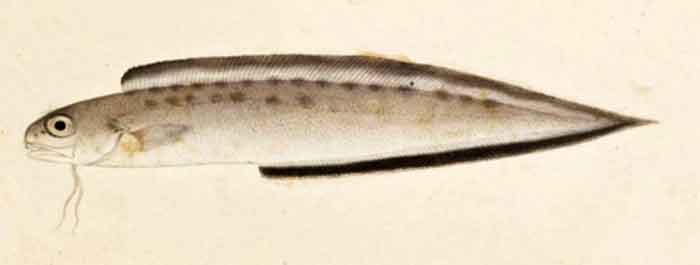Superregnum: Eukaryota
Cladus: Unikonta
Cladus: Opisthokonta
Cladus: Holozoa
Regnum: Animalia
Subregnum: Eumetazoa
Cladus: Bilateria
Cladus: Nephrozoa
Superphylum: Deuterostomia
Phylum: Chordata
Subphylum: Vertebrata
Infraphylum: Gnathostomata
Megaclassis: Osteichthyes
Superclassis/Classis: Actinopterygii
Classis/Subclassis: Actinopteri
Subclassis/Infraclassis: Neopterygii
Infraclassis: Teleostei
Megacohors: Osteoglossocephalai
Supercohors: Clupeocephala
Cohors: Euteleosteomorpha
Subcohors: Neoteleostei
Infracohors: Eurypterygia
Sectio: Ctenosquamata
Subsectio: Acanthomorphata
Divisio/Superordo: Acanthopterygii
Subdivisio: Percomorphaceae
Series: Ophidiaria
Ordo: Ophidiiformes
Familia: Ophidiidae
Subfamilia: Neobythitinae
Genus: Sirembo
Species: S. amaculata – S. imberbis – S. jerdoni – S. metachroma – S. wami
Name
Sirembo Bleeker, 1857
References
Nielsen, J.G., Schwarzhans, W. & Uiblein, F. 2014. Review of the Indo-West Pacific ophidiid genera Sirembo and Spottobrotula (Ophidiiformes, Ophidiidae), with description of three new species. Marine Biology Research 11(2): 113-134. Reference page.
Cohen, D.M.; Robins, C.R. 1986: A review of the ophidiid fish genus Sirembo with a new species from Australia. Memoirs of the Queensland Museum, 22(2): 253–263.

Sirembo imberbis
Sirembo is a genus of cusk-eels of the subfamily Neobythitinae, family Ophidiidae, which are found in the Indian and Pacific Oceans. The species in this genus have a rather robust body with the dorsal fin originating over vertebrae 1–5. The head and bod are completely covered in scales, they have large eyes which are almost equal in diameter to the length of snout, the pelvic fins have two rays which are joined together within an area of tough skin, They have a short spine on the operculum which does not extend to the posterior edge of the head. Their coloration is variable but almost all species have black spots or eyespots on the dorsal fin, sometimes both, while the middle part of the anal fin frequently has a black band. The body and/or head are marked with diagonal or horizontal dark stripes or horizontal rows of quite large dusky spots.[3]
The generic name is derived for the common name for the golden cusk in Japanese, sirembo.[4]
Species
There are currently 5 recognized species in this genus, although FishBase only recognizes 3:[5]
Sirembo amaculata Cohen & J. G. Nielsen, 1982 (Lined cusk) [2]
Sirembo imberbis Temminck & Schlegel, 1846 (Golden cusk)
Sirembo jerdoni F. Day, 1888 (Brown-banded cusk-eel)
Sirembo metachroma Cohen & C. R. Robins, 1986 (Chameleon cusk)
Sirembo wami J. G. Nielsen, Schwarzhans & Uiblein, 2014 [2]
References
Eschmeyer, William N.; Fricke, Ron & van der Laan, Richard (eds.). "Sirembo". Catalog of Fishes. California Academy of Sciences. Retrieved 14 July 2018.
Nielsen, J.G.; Schwarzhans, W. & Uiblein, F. (2014). "Review of the Indo-West Pacific ophidiid genera Sirembo and Spottobrotula (Ophidiiformes, Ophidiidae), with description of three new species" (PDF). Marine Biology Research. 11 (2): 113–134. doi:10.1080/17451000.2014.904885.
Dianne J. Bray. "Sirembo". Fishes of Australia. Museums Victoria. Retrieved 14 Jul 2018.
Christopher Scharpf & Kenneth J. Lazara (21 March 2018). "Order OPHIDIIFORMES: Families CARAPIDAE and OPHIDIIDAE". The ETYFish Project Fish Name Etymology Database. Christopher Scharpf and Kenneth J. Lazara. Retrieved 12 July 2018.
Froese, Rainer; Pauly, Daniel (eds.). "Species in genus Sirembo". FishBase. February 2018 version.
Retrieved from "http://en.wikipedia.org/"
All text is available under the terms of the GNU Free Documentation License

